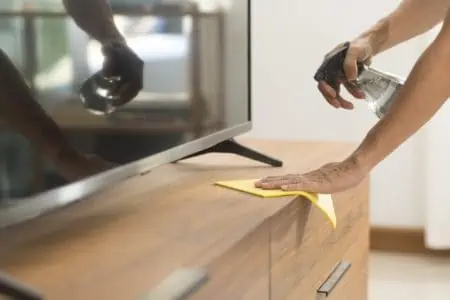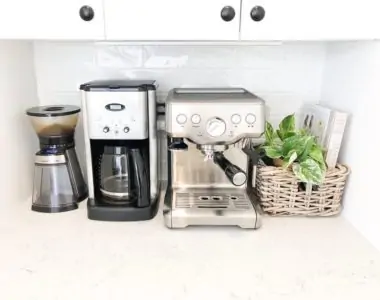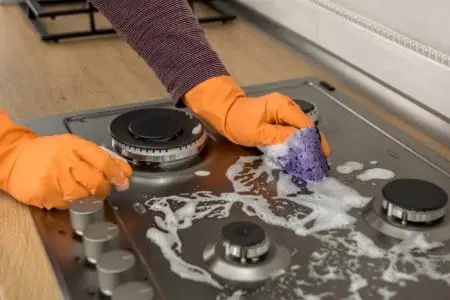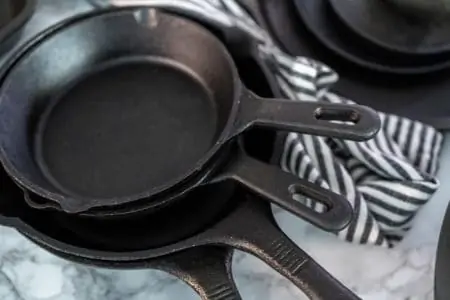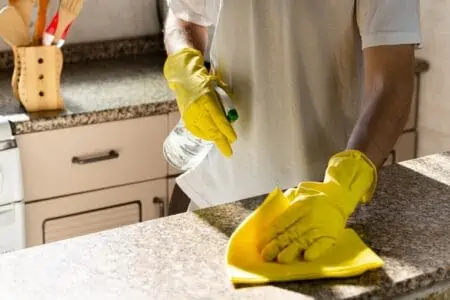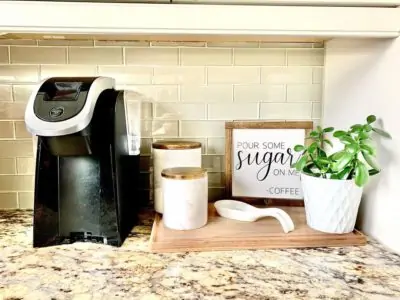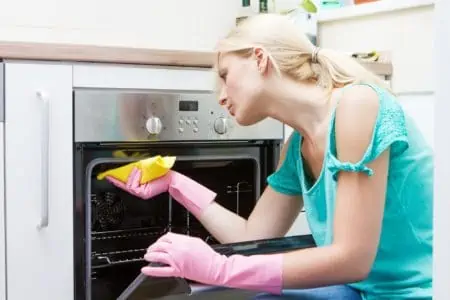Wood cabinets get just as dirty as other materials, but they are slightly more difficult to clean since you can’t use an all-purpose cleaner.
You don’t want to damage or stain your beautiful wood cabinets — so what’s the best way to clean them?
We’ll show you how to clean your wood cabinets using various methods. You’ll find one that works wonderfully for you without causing damage, ripping off the varnish, or destroying the wood.
Key Takeaways
- Use dish soap, vinegar, or a commercial wood cleaner to gently clean wood cabinets without damaging the finish.
- Remove tough stains with a baking soda paste or white toothpaste for water marks.
- Always rinse and dry cabinets after cleaning to prevent moisture damage.
- For extra shine, apply a wax- and silicone-free wood polish after cleaning.
Best Cleaner for Wood Cabinets
While you can make your own wood cabinet cleaner, some commercial cleaners are worth trying. Here are some popular options:
- Goo Gone All-Purpose Cleaner: Goo-Gone All-Purpose Cleaner is excellent for finished wood. It removes grease, grime, and other dirt that you’re sure to find in your kitchen. Good news, it also works on metals, sealed stone, fabrics, glass, and more.
- Weiman Wood Cleaner: This product restores, moisturizes, conditions, cleans, and protects. You can use it on cabinets, doors, oak furniture, and more.
- Method Daily Wood Cleaner: Method’s wood cleaner uses plant-based ingredients to remove dust and grime from your oak cabinets, walls, shelves, tables, and more. A lovely rich almond scent leaves behind a nice fragrance.
- Bona PowerPlus Wood Surface Deep Cleaner Spray: If you like an orange fragrance, you’ll love this. This strong cleaner cuts through grease and grime, which often builds up on kitchen cabinets. It leaves a residue-free finish. You can use it on cabinets, furniture, window shutters, tables, and more.
- Murphy 1910 Wood Cleaner: This natural cleaner is a very popular option and has been in the industry for over 100 years. It’s ideal for cleaning finished wood and hard surfaces, including cabinets. But it also works for hardwood floors, making this a versatile cleaner to have in the cupboard. You can even use it for laundry stains, ceramic, cars, leather, and vinyl.
How to Clean Wood Cabinets
Since you’ll be cleaning your wooden cabinets regularly, here are some of our favorite methods. We’ll share five different cleaning products, so you can choose the one that suits your home best.
- Time: 10-15 minutes
- Difficulty: Easy
What You’ll Need
- Cleaner of choice (Murphy’s Oil, vinegar, dish soap, baking soda, or toothpaste)
- Bucket or sink
- Water
- Cloths or sponges
- Nylon scrubbing sponge (for dish soap method)
- Spoon and bowl (for baking soda method)
- Gloves (optional)
With Murphy’s Oil
- Dilute cleaner: Fill a bucket or sink with one gallon of warm or hot water and ¼ cup of Murphy’s Oil Soap. Increase the quantities if necessary.
- Fill a separate bucket: Fill a separate bucket or sink with warm water.
- Apply cleaner: Dip a cloth or sponge in the first bucket or sink and rub the cabinets gently to clean. Open the door and wash the frame as well as the inside of the door. Repeat for each cabinet.
- Rinse: Use a clean cloth or sponge. Dip it in the second bucket or sink — the one that contains plain warm water. Wipe the cabinets down to remove cleaning residue and loosened dirt.
- Dry: Using a dry cloth, wipe the cabinets again to remove excess moisture.
Top Tip
Start at the top of your kitchen cabinets and work your way down. That way, if any dirt and debris fall, you will clean it at the end.
With Vinegar
- Dilute vinegar: Dilute a 1:1 ratio of distilled white vinegar and water in a sink or bucket.
- Apply vinegar: Dip a cloth or sponge into the solution and gently rub the cabinets clean. Open the door and wash the frames, too. Repeat for each cabinet, working from top to bottom.
- Dry: No need to rinse the vinegar off. Simply dry the cabinets with a separate dry cloth.
With Dish Soap
- Dilute soap: In a bucket or sink, dilute a few squirts of dish soap with about ½ gallon of hot water.
- Apply cleaner: Dip a nylon scrubbing sponge into the solution and clean your cabinets. Move in gentle circular motions from top to bottom. Don’t apply too much pressure. You don’t want to scratch the cabinets.
- Tackle stains: If you have stains or caked-on grease, you can apply the dish soap directly to the sponge. Use a little more elbow grease to scrub off stains from the cabinet.
- Rinse: Empty the soapy water and fill the sink or basin back up with plain warm water. Dip a cloth in the water and wipe the cupboards to rinse them off.
- Dry: Use a separate dry cloth to dry the cupboards.
With Baking Soda
- Make a paste: Make a paste mixing equal parts baking soda and water. You might need to adjust the quantities slightly to make a smooth paste.
- Apply paste: Dip a cloth in the paste and apply it to caked-on stains and grease on your cabinets.
- Leave: Leave the paste to soak for 15 minutes.
- Scrub: Use a damp microfiber cloth to scrub the paste away. You will loosen off any residue while you do this. Continue until the caked-on elements have come off.
- Repeat and rinse: Repeat if necessary. Then rinse with a damp cloth to remove baking soda residue.
With Toothpaste
Wondering how to clean wooden kitchen cabinets with toothpaste? You might have heard this hack. But remember — toothpaste isn’t suitable for cleaning the entire cabinet, but it’s great for stains, especially water marks.
- Apply toothpaste: Squirt a bit of white toothpaste (no gel) onto a cloth.
- Rub: Rub the toothpaste directly onto the stain in circular motions. Don’t scrub too hard. Soon, you should see the stain begin to lift.
- Stop: If it’s been 10 minutes and the stain hasn’t lifted, stop. You don’t want to strip the varnish or ruin the wood.
- Rinse: Dampen a clean cloth in warm water and wipe away the toothpaste residue.
How to Clean Stained Wood Cabinets
While some of the above hacks work for removing stains, here’s a thorough guide for removing dark marks and stubborn grease from your cabinets.
- Time: 25 minutes
- Difficulty: Easy
What You’ll Need
- Distilled white vinegar
- Bucket or sink
- Water
- Olive oil
- Rubber gloves
- Cloths
- Baking soda
- Bowl
- Spoon
- Wood polish (optional)
1. Prepare Cleaner
For this method, we’ll be using the naturally occurring power of vinegar and oil. Together, these create a fantastic wood cleaner that can remove stains and clean your wood. We use it on our wood furniture, and it’s incredible!
Mix a 1:1 solution of white vinegar and hot water in a bucket or sink. Add a few drops of olive oil. Mix well.
2. Apply Cleaner
Wearing rubber gloves to protect your hands, dip a cloth into the cleaning solution. Wring it out so that it’s not sopping wet or dripping. Gently scrub the cabinets, focusing on stained areas to remove marks, grease, and other dirt. Repeat across all cabinets, working from top to bottom.
3. Remove Extra Stains
If there are marks that don’t come off with the above method, you should make a baking soda paste and apply it to stained spots. You can use the “With Baking Soda” method from above to do so.
4. Rinse and Dry Cabinets
Use a separate damp cloth to rinse the cabinets to remove the baking soda and vinegar residue. Dry them with a separate cloth.
5. Apply Wood Polish
Once the cabinets are dry, apply a wax- and silicone-free wood polish to protect your cabinets and bring back a nice shine. Follow the packaging instructions for specific advice.
How to Polish Wooden Cabinets
You can use the above ‘With Murphy’s Oil” and “With Vinegar” cleaning methods on your cabinets to make them shine. But if you want to polish your wooden cabinets to perfection, then using a store-bought wood polish is your best option. Make sure to follow the manufacturer’s instructions for the best application method, as this will vary from brand to brand.
Cleaning Different Types of Cabinets
The above cleaning methods are specifically for finished wood that hasn’t been painted. But if you have laminate (fake wood) cabinets or painted wood cabinets, you’ll still want to get them clean. Here are some specific cleaning instructions for this type of wood.
Laminate Cabinets
You can use diluted vinegar, an all-purpose cleaner, or dish soap to clean laminate. You can use the “With Vinegar” or “With Dish Soap” methods mentioned above. If using an all-purpose cleaner, ensure it’s water-based. Read the packaging instructions for the best advice.
You should also make sure that you don’t soak the laminate cabinets. Always wring out your cloth or sponge well before applying the cleaner.
For cleaning wood cabinet stains, a baking soda paste will work wonders on laminate. Another option is to soak a cloth with lemon juice and wipe the stained area.
Always rinse and dry laminate cupboards after cleaning. Avoid scouring tools, wire brushes, and other abrasive cleaners.
Painted Wood Cabinets
The best method is the “With Dish Soap” method. It will clean your painted cabinets without removing any finish.
Instead of using a nylon scrubbing brush, use a soft, lint-free, microfiber cloth to avoid damaging the paint. Always rinse the cabinets well before wiping dry with a separate cloth.
Wooden Cabinet Cleaning Tips
Here are some extra tips for taking the best care of your wooden cabinets:
- No air drying: Don’t let your wood air dry. Leaving moisture on the wood for a prolonged period of time can cause damage.
- Dust often: When you don’t have time to clean your cabinets, a quick dusting can work wonders. It removes surface-level dust and debris and prevents stains.
- Don’t soak: When using water to clean your kitchen cabinets, always wring the cloth or sponge out really well. Too much moisture can damage the wood.
- Use vinegar and oil sparingly: While vinegar and oil are great from time to time, such as for removing stains, be careful. Vinegar can remove paint and varnish if you use it too often. As for olive oil, it doesn’t dry. It can add too much moisture to the wood and cause damage. Only use a small amount and buff the cabinet afterward to remove excess moisture.
- Work from top to bottom: If you start at the top, you will catch any loosened and dripping grime as you work your way downwards.
- Don’t forget the trim and frame: Grease and dirt harbors in the nooks and crannies of your cabinet. So make sure you open the door and clean the frame and trimming.
How to Restore a Wooden Cabinet
If your wooden cabinets are old or worn, you can restore them without having to buy new cabinets. For this, you can use a stain or paint.
Using a Stain
Start by choosing your color. You can go lighter or darker. Always clean and dry your cabinets first. Sand them slightly, then use a cloth to remove dust. Then apply your stain following the manufacturer’s instructions.
If choosing a lighter stain, you will need to remove as much of the old stain as possible using a paint remover. If you have dents, cracks, or scratches, fill them with wood filler. Clean, dry, and sand the cabinets before applying your stain. Let it dry, then add a coat of protective wood sealer. Rub the cabinets dry with a 000 steel wool. Clean once more with a soft, lint-free cloth.
Using paint
If you are repainting your cabinets, start by removing the old paint with a paint stripper. You might also need to scrape off excess parts of the old finish. Use a wood filler to fix surface damage. Once the cabinet is dry, sand it lightly with 100 grit sandpaper, then 180, then 220.
Now, it’s time to paint the cabinets using your preferred color. When dry, give the cabinet a quick clean before applying sealer. Once the sealer is dry, rub the cabinets with 000 steel wool and wipe with a soft, lint-free cloth.
